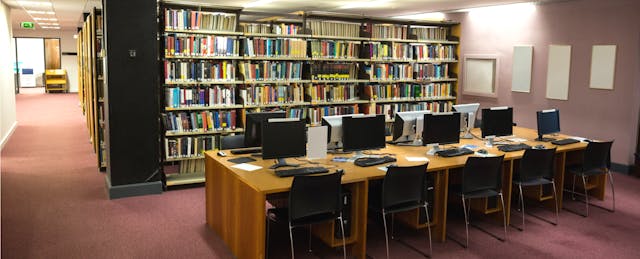Libraries offer a refuge where students study, find books or take the occasional nap. But could these places soon provide additional services beyond homework help?
A new report this week explores whether libraries can play a more proactive role in helping community college students succeed. Researchers started by first asking 37 students from seven community colleges what challenges they face, which will inform the next phase of the project: devising ways to test whether libraries can assist with barriers around, say, finances, childcare, transportation and other challenges.
When it comes to student success, “there is a lot of conversation about guided pathways, advising, on-time registration, all these other sorts of practices,” says Dr. Braddlee, an author of the report and dean of learning and technology resources at Northern Virginia Community College. “But there has been less focus on the role a library can play in that.”
Among the report’s main findings: students and schools don’t always define “student success” by the same measures. Unlike metrics like transfer or completion rates, which colleges often use, students in the study pointed to intrinsic goals, such as career advancement and skill mastery, as stronger personal measures of success.
“They were really thinking more broadly about wanting to better themselves and help their families,” says Christine Wolff-Eisenberg, a researcher at Ithaka S+R who led the study with Braddlee. “It was so much broader than those extrinsic goals that are so often the measures we think of when we think of student success.”
Other findings in the report match broader trends about challenges community college students face including difficulties navigating financial aid and covering food and housing costs. A 2017 study from the HOPE Lab in Wisconsin similarly shows that nearly half of community college students lack secure housing, and about 67 percent are food insecure.
Students interviewed in this Ithaka S+R report also struggle with family obligations and covering childcare during class. “My wife also works full-time and takes classes during the evenings, so we have to ask her family or my family [or] get a babysitter, which is not cheap, to watch the kids while we’re both in school,” one student in the report says.
With these issues in mind, the next phase of the project will focus on designing and testing ideas around how libraries can provide relevant supports. Exact strategies have yet to be finalized, but Braddlee says they are looking at examples such as how some colleges keep toys and children’s books at the library for parents to rent while they are studying if they bring their kids, or reserve private study rooms for student-parents.
Part of researching these ideas will also mean determining what services a library should not take on. “I don’t think turning the library into a full-time daycare center would be appropriate or practical,” says Braddlee. Wolff-Eisenberg echoes: “We don’t want to breach what the library could or should be doing.”
The project will also look at how the library can better connect students to services in and outside of the library. For example, Wolff-Eisenberg says that at Pierce College in Washington, a campus included in the study, students are required in their first term to visit the library and meet with a librarian. Pierce students were more likely to utilize the librarian later on than students from other campuses.
After the researchers test out ideas around adding student support networks to libraries, the survey methodology will be made available (likely in Spring 2019) as an openly-licensed tool for other community colleges to adopt and identify their own campus needs.


